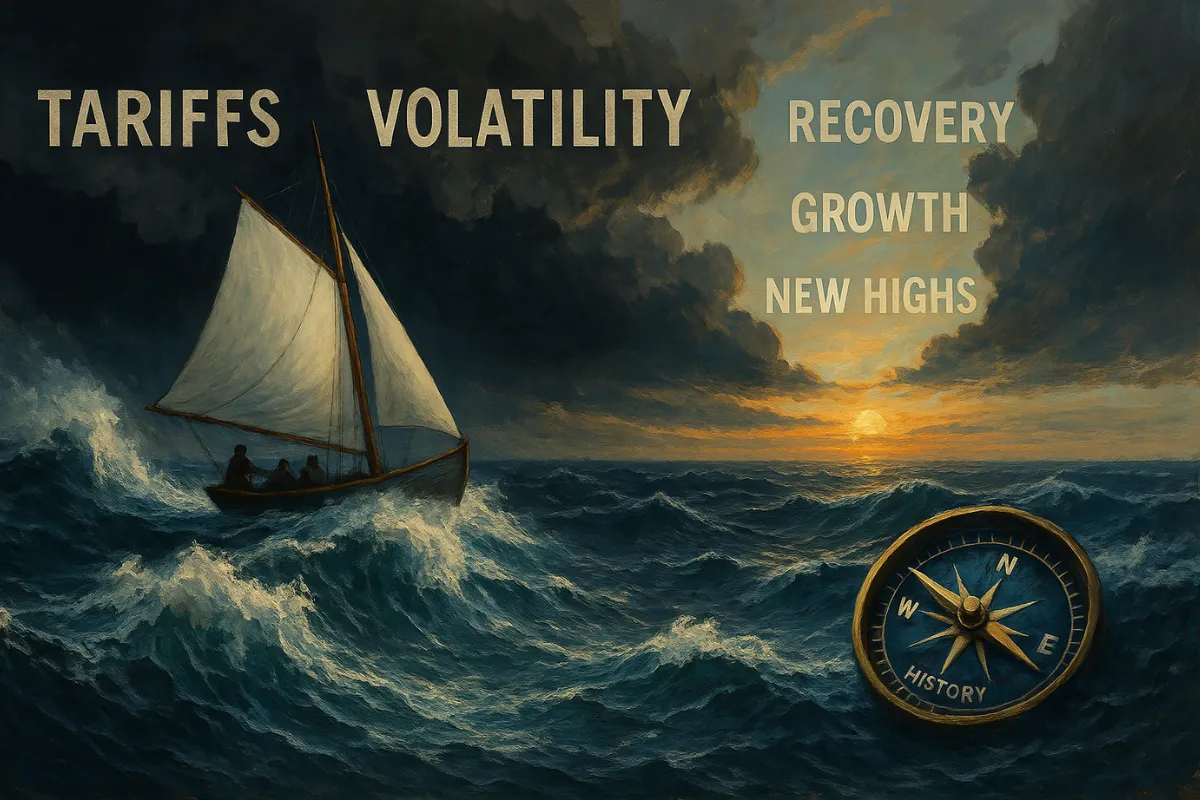BLOG

Uncertainty and Unpredictability
These two words have been repeated in almost every news article these past couple of months as it relates to the stock market and new policies rolling out seemingly daily from Washington. However, there are far more well-established certainties and predictability with the US stock market and economy.
First, let’s focus on the recent uncertainties (in case you didn’t notice them). Today marked the fourth consecutive day of massive stock market volatility. Since President Trump surprised the world by presenting his new tariff schedule in the Rose Garden last Wednesday coined as Liberation Day, institutional investors worldwide opened the next trading day aggressively selling their stock holdings. Unlike most of us who can ride out market ups and downs, institutional managers have extensive options and future positions that some need to be settled at the close of the same day. If the market begins an aggressive down cycle institutional investors must sell to cover their derivative contracts which further exacerbates the down cycle. Established hedge funds have gone bankrupt as the result of a single high volatile day. The panic selling sent stock exchanges around the world into a tailspin.
Monday the US stock market had its highest trading volume in the last 18 years with over 29 billion shares traded. For the day, the Dow Jones Industrial Average (DJIA) index had a historic and wild intra-day swing of 2,595 points. As a recap, the DJIA opened Monday down 1590 points from Friday’s close and shortly after began to slowly recover. Then at 9:44 ET investors suddenly reversed from selling to aggressively buying stocks. Within 33 minutes investors drove the DJIA up 2546 points until it was determined the announcement that President Trump was reversing his position on tariffs was fake news. DJIA dramatically reversed again and dropped 1842 points. The index recovered again to close the day down -0.96%. Indeed, it was a wild day for stock day traders but when the dust settled the DJIA closed down less than 1%.
The last four days have been erratic but not unique. On Friday, the S&P 500 dropped nearly 6%, its worst day since March 16, 2020, when the index plunged by 11.98%.
In the last four trading days, the CBOE Volatility Index (VIX) has soared to 52.9 which is well below the previous all-time high of 82.69 reached on March 30, 2020, and below the 2008 high of 69.96.

Worth knowing is that a few days prior to March 30, 2020, when the VIX reached an all-time high, the stock market had already initiated a new positive trend that continued to December 2021. During this period the S&P 600 Small Cap index rallied 104.5% and NASDAQ increased 101.2%. This rally ended when the Federal Reserve began its rate hike campaign to slow inflation.

For reference, Investopedia defines the VIX as follows:
“CBOE Volatility Index is a real-time index that represents the market’s expectations for the relative strength of near-term price changes of the S&P 500 Index (SPX). Because it is derived from the prices of SPX index options with near-term expiration dates, it generates a 30-day forward projection of volatility. Volatility, or how fast prices change, is often seen as a way to gauge market sentiment, and in particular the degree of fear among market participants.”
The current administration seems to be keeping everyone on a need-to-know basis and the uncertainty is prompting investors to sell their stock holdings. Investors need to determine the prospects of corporate earnings and will remain very cautious until there is better clarity on the cost of importing and exporting materials. Since April 2, the major indices have plunged at rates that are near but not as significant as the selloffs in 2020 or 2022.

Now let’s discuss the certainties of which there are plenty. First, the overall US stock market, as represented by the DJIA established in 1896, has always recovered from every market correction and economic slowdown. This is true for all major indices created since including the tech-focused NASDAQ. To repeat, the stock market, as represented now by many indices, has always recovered after a correction (consider a decline of -10% or greater from its previous peak). Only four times since 1960, has the S&P 500 declined greater than 10% in two consecutive days which were in 1987, 2008, 2020, and last week.
CNBC noted this past Saturday the following observation of last week’s two trading days:
“The 10% Thursday-Friday collapse in the S&P 500, making it 17.4% below its Feb. 19 record high, ranks among the deepest two-day declines in more than 70 years: October 1987 (Black Monday), November 2008 (post-Lehman collapse) and March 2020 (the Covid crash). Not all were at an absolute low, but fierce rallies ensued soon afterward each time.”
Notice that after each of the worst two consecutive trading days, the stock market and economy began to recover shortly thereafter. Scott Becker, Senior Vice President and head of Portfolio Specialists at Calamos Funds, made the following observation in 2021:
“This chart shows the maximum intra-year equity market drawdowns since 1980. From this, we can see how frequently at least one double-digit decline occurs within any given calendar year. In 22 of the last 42 calendar years—more than half of the time—the S&P 500 saw a double-digit pullback within the year.
In every year, there was a market pullback and on average the market experienced a 13% decline. In the years when the S&P did experience a double-digit decline, 14 of those 22 times—or 64% of the time—the market ended the year with a positive return.”

Stock market corrections as we are experiencing now are not an anomaly but in reality, a consistent and predictable occurrence. In fact, when the stock market has consecutive multi-year stock market double-digit gains without a meaningful drawdown, the predictable outcome is a significant multi-year correction. The most memorable experience is the historic years of 1995 to 2000. During these years the S&P 500 soared 219% and the NASDAQ with the dot.com boom rocketed up 441%.

However, this massive extended rally set up a devastating selloff that lasted nearly three years wiping out trillions in market capitalization.

What Does This Mean to Me?
For long-term investors, market volatility, for any reason with or without merit, is predictable and to be expected. For astute investors, these annual corrections are new buying opportunities.
Certainly, there is much to question in the recent tariff announcements that have been met with significant criticism and questioned by institutional investors and analysts. The bizarre tariff formula to define the retaliatory tariffs added more confusion and doubt about the logic of these new policies.
However, the 33-minute rally on Monday that sent the DJIA soaring 2500 points on the rumor that President Trump was reversing his tariff position, clearly indicates that the selloff is singularly due to the concerns about the tariff policies and not due to concerns about the economy tariff issue excluded. Tariffs don’t last forever, and the administration has said several times that the new tariff schedule may be applicable for weeks or months but not long term.
Therefore, at some point, investors will begin to rebuild their stock portfolios due to extreme stock values or when the administration’s tariff policies are relaxed. Unless this is the first time in the history of this country, the stock market will begin yet another new positive trend at some point that will recover recent loses and continue to new all-time highs. However, the caveat is the only way to participate in the next rally is to be invested.
Give us a call or send us an email with your comments on this Issue. Better yet, let’s schedule a time to discuss your long-term financial plans and how we may be able to assist you in achieving these goals.
CONTACT
Check the background of your financial professional on FINRA's BrokerCheck.
The content is developed from sources believed to be providing accurate information. The information in this material is not intended as tax or legal advice. Please consult legal or tax professionals for specific information regarding your individual situation. The opinions expressed and material provided are for general information, and should not be considered a solicitation for the purchase or sale of any security.
We take protecting your data and privacy very seriously. As of January 1, 2020 the California Consumer Privacy Act (CCPA) suggests the following link as an extra measure to safeguard your data: Do not sell my personal information.
The information on this website is the opinion of Up Capital Management and does not constitute investment advice or an offer to invest or to provide management services. Before purchasing any investment, a prospective investor should consult with its own investment, accounting, legal, and tax advisers to evaluate independently the risks, consequences, and suitability of any investment.
Copyright 2024 | Privacy Policy | Terms & Conditions

